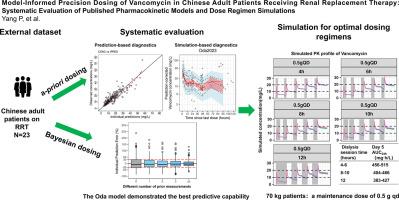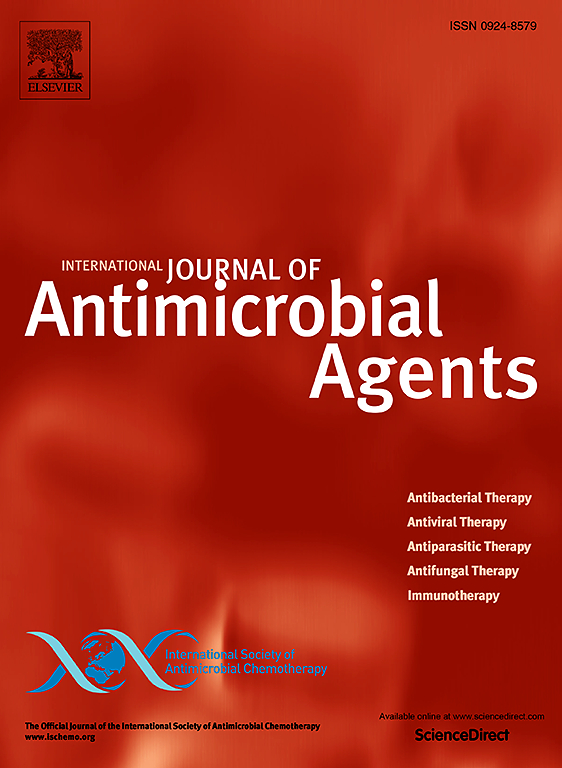在接受肾脏替代治疗的中国成年患者中,基于模型的万古霉素精确给药:已发表的药代动力学模型和给药方案模拟的系统评价。
IF 4.6
2区 医学
Q1 INFECTIOUS DISEASES
International Journal of Antimicrobial Agents
Pub Date : 2025-09-03
DOI:10.1016/j.ijantimicag.2025.107608
引用次数: 0
摘要
目的:在接受肾替代治疗(RRT)的危重患者中,肾脏清除万古霉素的药代动力学发生显著改变,影响治疗目标的实现。我们评估了基于RRT患者的基于模型的精确给药PopPK模型的预测性能,并随后模拟了该人群的最佳给药方案。方法:使用来自两个研究中心的23名成人RRT患者的226个浓度数据集,系统地鉴定和评估了6种成人PopPK模型。通过模拟和基于预测的诊断来评估基于患者特征的先验给药和包含多个测量谷浓度的贝叶斯给药的预测性能。结果:Oda模型在基于预测的评价中表现最好,预测误差中位数为-8.4%。贝叶斯预测包含至少一个测量谷浓度提高了预测能力,并且在模型中包含透析过滤器特性可能进一步提高其性能。在这种情况下,对于体重70公斤的患者:在第一次透析期间给予1 g负荷剂量,在24-48小时内达到目标浓度。透析后应给予0.5 g维持剂量。延长透析时间(≥12小时)需要增加剂量。结论:Oda模型对中国成人RRT患者的剂量预测能力最好。然而,与F20≥35%和F30≥50%的标准外部评价标准相比,其F20和F30值略显不足,需要进一步研究优化模型或收集额外的数据来验证其性能。本文章由计算机程序翻译,如有差异,请以英文原文为准。

Model-informed precision dosing of vancomycin in Chinese adult patients receiving renal replacement therapy: Systematic evaluation of published pharmacokinetic models and dosing regimen simulations
Objectives
The pharmacokinetics of renally cleared vancomycin are significantly altered in critically ill patients undergoing renal replacement therapy (RRT), affecting the achievement of therapeutic targets. We evaluated the predictive performance of RRT patient-based PopPK models for model-informed precision dosing and subsequently simulated optimal dosing regimens for this population.
Methods
Six adult PopPK models were systematically identified and evaluated using a dataset of 226 concentrations from 23 adult patients on RRT from two study centers. Predictive performance was assessed using simulation and prediction-based diagnostics for a priori dosing based on patient characteristics and Bayesian dosing incorporating more than one measured trough concentration.
Results
The Oda model showed the best performance in prediction-based evaluation, with a median prediction error of –8.4%. Bayesian forecasting incorporating at least one measured trough concentration improved predictive capability, and the inclusion of dialysis filter characteristics in the model may further enhance its performance. For a 70 kg patient under this scenario: A 1 g loading dose during the first dialysis session achieves target concentrations within 24–48 h. Subsequent 0.5 g maintenance dose should be administered post-dialysis. Dose escalation is required for extended dialysis sessions (≥12 h).
Conclusion
The Oda model demonstrated the best predictive capability for dose prediction among the tested models in Chinese adult patients receiving RRT. However, its F20 and F30 values were undershot compared to the standard external evaluation criteria of F20 ≥35% and F30 ≥50%, highlighting the need for further study to optimize the model or collect additional data to validate its performance.
求助全文
通过发布文献求助,成功后即可免费获取论文全文。
去求助
来源期刊
CiteScore
21.60
自引率
0.90%
发文量
176
审稿时长
36 days
期刊介绍:
The International Journal of Antimicrobial Agents is a peer-reviewed publication offering comprehensive and current reference information on the physical, pharmacological, in vitro, and clinical properties of individual antimicrobial agents, covering antiviral, antiparasitic, antibacterial, and antifungal agents. The journal not only communicates new trends and developments through authoritative review articles but also addresses the critical issue of antimicrobial resistance, both in hospital and community settings. Published content includes solicited reviews by leading experts and high-quality original research papers in the specified fields.

 求助内容:
求助内容: 应助结果提醒方式:
应助结果提醒方式:


